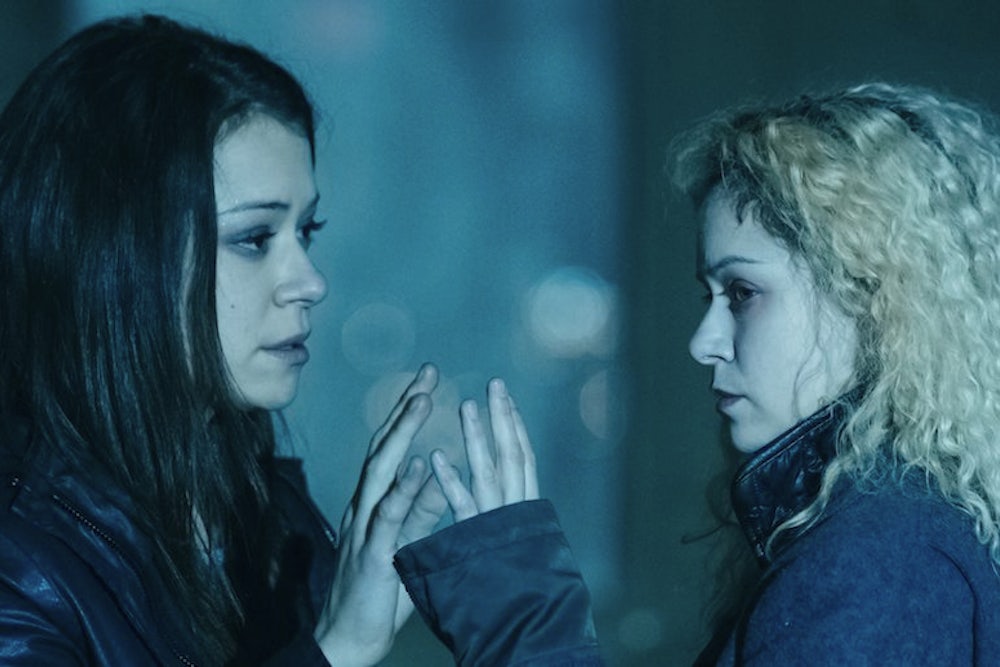Midway through the disorienting finale of “Orphan Black,” which airs tomorrow, the hectic, conspiracy-strewn plot is briefly interrupted by a silent dance party. Exhausted from fighting creepy doctors and cult leaders, four women shake and sway to a generic reggae dance track: Cosima, a dreadlocked hippie scientist; Sarah, a punky grifter; Alison, a high-strung soccer mom; and Helena, a childlike Ukrainian psychopath with a head of Shakira curls. Watching them dance, it took me a few minutes to realize exactly what made this scene so mesmerizing: These four women, whose body language was so dissimilar, are all played by the same woman—Tatiana Maslany, the show’s virtuoso lead.

Maslany’s performance is the most pronounced virtue of “Orphan Black,” and it’s impossible to praise enough. Playing all the clones at the show’s center, the Canadian actress slips seamlessly between characters. (At this point I’ve lost count.) This season even introduced Maslany as a transgender man named Tony. But the show isn’t just a vehicle for Maslany’s Meryl Streeping, and in its second season, the pulpy thriller has become thematically richer even as its plotting grows more muddled. Though I can’t quite always keep the villains straight—there are corporate suits, military experiments, religious fanatics who hate science, and religious fanatics who like science—they all force the clones into a struggle for reproductive freedom. “Orphan Black” takes its brash feminism for granted, as its characters assert their humanity in the face of institutions that see them as experiments or genetic miracles or walking wombs. The clones never doubt their individuality. “There’s nine of you?” Paul—a hired-hand clone-minder-turned-love-interest—asked Sarah last season. She replies, “No, there’s only one of me.”
In the finale’s opening scene, Sarah is prodded and questioned by medical examiners: “Are you ovulating? When did you first have sexual intercourse? Have you ever had an STD? Have you ever been diagnosed with a reproductive disorder? Have you ever had an abortion? Do you use birth control?” The dehumanizing interrogation is only the latest instance in a string of plot developments that make it clear that the clones have been reduced to soulless bodies—their genetic code patented, their eggs harvested. In a recent episode, Rachel, the powerful semi-villainous clone at the top of the corporation that created them, finds out why she and the rest of her sisters are unable to have children: the clones are barren by design, not genetic error. Behind Rachel’s cold eyes, she crumbles, as she realizes one more choice has been taken from her.

Filling the show with so many versions of Maslany has the curious effect of shunting the straight male characters off to the sidelines, playing helpful sidekicks or inept villains. (Slate has praised the show’s “brilliant misandry,” which is going a bit far.) But “Orphan Black” both takes female characters as its subject and is guided by the female perspective—an even more rare quality for TV. In an essay on Salon this week, Lili Loofbourow criticized “Game of Thrones,” and cable drama more generally, for ignoring female desire: “The erotic—from a female viewpoint—rarely finds its way onscreen,” Loofborouw writes. While “Orphan Black” is basic cable—no butts, no boobs, definitely no dicks—it embodies that female gaze better than anything else on television right now. In sex scenes, the camera glances past Maslany’s body to linger on beefcake abs. Sarah’s two love interests, Paul and Cal, take on the role of Bond girls—objectified eye candy who spend their time helping our heroine or betraying her. Paul is a Ken Doll, and Cal is Your L.L. Bean Boyfriend come to life. Even when she uses sex as a distraction—jumping Paul when he begins to suspect her identity last season—Sarah isn’t a femme fatale or vixen. The focus is her desire, not his. When Paul has sex with Rachel this season, he’s like a stallion at a livestock auction. She commands him to undress, inspects his body, appraises his teeth, pours him a glass of wine and won’t let him drink it.
As a show chiefly concerned with the ways women’s bodies are commodified and controlled, “Orphan Black” is careful not to view its female characters with that same hungry eye. This is a triumph: On so many shows, the camera works at cross-purposes to the high-minded themes. “Game of Thrones” depicts women and girls straining against a world that abuses and sexualizes their bodies—then it glamorizes and fetishizes that abuse. “True Detective” criticizes men who violate girls, then lovingly reduces women to bouncing breasts or artfully posed corpses. Even works that embrace a you-go-girl ethos too often use a soft-core aesthetic. In J.J. Abram’s “Alias,” which “Orphan Black” often echoes in storytelling and style, Jennifer Garner’s bikini-clad body was practically a special effect. But here, the men’s bodies are the only ones on display. Women are tied up, tied down, held captive, inseminated, their mouths sewn silent. On another show, these images might be filmed as torture porn. One of “Orphan Black”'s singular virtues is the way it avoids this voyeuristic lens.
